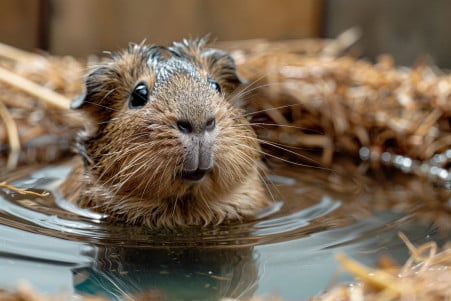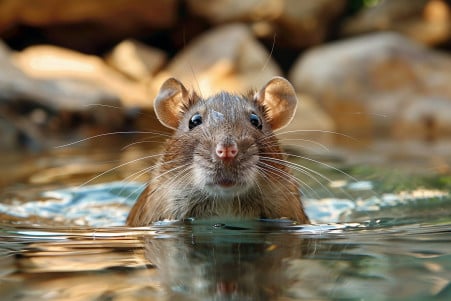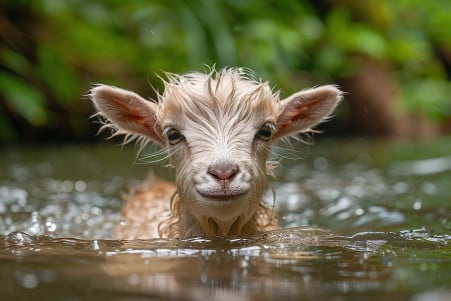Do Rabbits Swim? What to Know About Their Aquatic Capabilities
9 February 2024 • Updated 9 February 2024

While rabbits are often associated with hopping, their interaction with water may be less expected. Yes, rabbits can swim, but they do so mostly out of necessity and not for fun. In fact, pet rabbits should not be made to swim because it can lead to stress and other health problems. However, it is important to make sure that their living space is safe and secure to avoid the risk of drowning.
This article takes a deep dive into veterinary research, animal behavior studies, and ecological evidence to explore the swimming capabilities of rabbits and the stress that comes with it.
It also looks at the physical and instinctual factors that play a role in rabbits’ ability to swim, as well as the environmental factors in the wild that may have contributed to these capabilities. This article will give you a more complete picture of rabbits’ relationship with water, so you can make sure you’re taking the best care of these animals.
Do rabbits have the ability to swim?
Swamp Rabbits and the Evolution of Swimming in Rabbits
While rabbits might not be the first animal that comes to mind when you think of swimming, some wild rabbits, like the swamp rabbit, are excellent swimmers. According to PBS, swamp rabbits are able to swim so well because of their musculature and buoyancy. While this might seem like a fun party trick, the ability to swim has important evolutionary implications.
For example, swamp rabbits swim to move through flooded areas, which helps them escape predators and find the different habitats they need to survive. As a result, this ability is likely an adaptation to the environmental conditions of their habitats.
Meanwhile, the Eastern Cottontail, which is found in southern Michigan, is most common in edge habitats with frequent water sources, according to the Landowner’s Guide to Eastern Cottontail Rabbits. In these edge habitats, swimming may be an important way for Eastern Cottontail rabbits to move between the different areas they live in.
Clearly, water plays an important role in the ecology of these wild rabbits. It helps them escape, acts as a barrier, and helps them find the resources they need. This is just one example of how the relationship between these rabbits and their environments has led to their success, according to a comprehensive review in Animals. This brings us to our next topic, which will discuss how anatomical and muscular factors help rabbits swim.
A Look at the Anatomy of Aquatic Agility in Rabbits
While rabbits are not typically considered swimmers, their skeletal and muscular systems have some features that could enable swimming. A paper in PubMed by F.T. Blevins shows that there are significant differences in the architecture of rabbit hindlimb muscles when they are broken down by function.
The paper explains that the rabbit’s large hind limbs and robust muscles are a sign of their potential to swim. It goes on to say that the design of muscle fibers in rabbit limbs is consistent with adaptations for force production and large excursions, which are both important for swimming.
That said, not all rabbits are created equal when it comes to their ability to swim. A thorough review in the Cuniculture guide of rabbit anatomy suggests that domestic rabbits may not have the same muscle architecture as wild rabbits, like swamp rabbits, who are known to swim.
Citing sources like the Atlas d'Anatomie du Lapin, the review lists differences in the skeletal muscles of domestic rabbits that could impact their ability to swim. This leads to the question of whether the body of the domestic rabbit is actually built for swimming.
This is important to know because these anatomical and muscular differences will directly impact how rabbits respond to being placed in water. While rabbits may have the physical ability to swim, the stress of being in water can lead to a number of physiological changes and health issues, which will need to be taken into account in their care.
How Stress Affects Rabbits Forced to Swim
The stress of water exposure can be quite severe for rabbits, and it can have both immediate and long-term effects on their health. Stress of any kind, including heat stress and predator stress, causes physiological changes in rabbits.
In a study in the Journal of Animal Physiology and Animal Nutrition, Waleid M. E. Shakweer explains that stress, including heat stress, reduces blood antioxidants and increases oxidative stress markers in rabbits. This is important because it shows that the rabbit’s body is sensitive to stress and that the same kind of response can be expected from the stress of water exposure.
The health effects of the stress of swimming are serious. Oxidative stress, which is described in the Journal of Animal Physiology and Animal Nutrition, can lead to organ damage, and this can be even worse if the rabbits are unable to adapt to the stressor.
A study in PMC explains that oxidative stress and disrupted endocrine regulation can lead to immune suppression and reproductive issues, and this is especially true when rabbits are swimming while stressed.
It is important to be able to recognize signs of stress so that rabbits can be properly cared for. Look for signs of stress, including anxiety, depression, and a decrease in food consumption, as described in a study in PubMed.
This can help those who care for rabbits understand how to approach the rabbits, and it can help them make sure that they are working to reduce water exposure and the risks that come with it. Going forward, it is important to understand the practical rabbit care and water safety tips that can help keep these sensitive animals safe.
How to Protect Your Rabbit from Water Hazards: Tips for Rabbit Owners
Keeping rabbits safe from water hazards requires practical measures to ensure their well-being. A-Z Animals notes that it’s important to make sure that any areas where rabbits are allowed to roam are enclosed in a way that prevents them from getting to bodies of water, such as swimming pools or ponds, where they could drown.
Make sure that you have a safe, dry enclosure for your rabbit that you can put them in when you can’t supervise them to prevent any unscheduled swimming.
Of course, it’s also important to emphasize the need to supervise rabbits around water. Hepper points out that the stress and potential health problems that can be caused by exposing rabbits, especially pet rabbits, to water are many. This includes the potential for heat stress and skin irritation from chemicals like chlorine in pools. Supervision is key to preventing these stressful situations.
In terms of bathing, never submerge or soak your rabbit. Instead, spot clean them with a damp cloth to remove dirt, which is less stressful for your pet.
If your rabbit does end up in water, remove them from the water calmly and quickly to minimize their stress, Hepper says. Dry them off gently with towels and keep them in a warm, quiet place to help them recover.
By taking these steps, you can help ensure that your rabbit is safe and healthy, and that their living situation is as stress-free as possible, which is important for their well-being, natural behavior, and health.
Concluding Thoughts: Rabbits and Water—How to Respect Instincts and Needs
In conclusion, while rabbits can swim, they only do so when they have to, not because they want to. Certain wild rabbits, like swamp rabbits, have evolved to be good swimmers as a result of their environment, and this is a trait that may or may not have been passed down to domestic rabbits.
While their strong back legs suggest that they could swim, it’s possible that domestic rabbits don’t have the musculature necessary to be efficient swimmers.
In addition, it’s important to note that the stress that rabbits experience when they are exposed to water is a big deal. A study in the Journal of Animal Physiology and Animal Nutrition notes the physiological changes and the potential for oxidative stress, which can lead to a number of health issues.
This is why it’s so important to know the signs of stress in rabbits and to make sure that they aren’t exposed to water unnecessarily.
That said, it’s important for rabbit owners to make sure that they are taking steps to protect their pets from water-related hazards while also respecting their natural instincts. As people who are responsible for their well-being in a domestic environment, it’s our job to make sure that we are striking a balance between their natural inclinations and their safety and comfort in our care.


